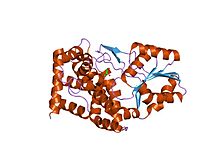Liver alcohol dehydrogenase
| alcohol dehydrogenase | |||||||||
|---|---|---|---|---|---|---|---|---|---|

|
|||||||||
| Identifiers | |||||||||
| EC number | 1.1.1.1 | ||||||||
| CAS number | 9031-72-5 | ||||||||
| Databases | |||||||||
| IntEnz | IntEnz view | ||||||||
| BRENDA | BRENDA entry | ||||||||
| ExPASy | NiceZyme view | ||||||||
| KEGG | KEGG entry | ||||||||
| MetaCyc | metabolic pathway | ||||||||
| PRIAM | profile | ||||||||
| PDB structures | RCSB PDB PDBe PDBsum | ||||||||
| Gene Ontology | AmiGO / EGO | ||||||||
|
|||||||||
| Search | |
|---|---|
| PMC | articles |
| PubMed | articles |
| NCBI | proteins |
| alcohol dehydrogenase 1A, α polypeptide |
|
|---|---|
| Identifiers | |
| Symbol | ADH1A |
| Alt. symbols | ADH1 |
| Entrez | 124 |
| HUGO | 249 |
| OMIM | 103700 |
| RefSeq | NM_000667 |
| UniProt | P07327 |
| Other data | |
| EC number | 1.1.1.1 |
| Locus | Chr. 4 q23 |
| alcohol dehydrogenase 1B, β polypeptide |
|
|---|---|
| Identifiers | |
| Symbol | ADH1B |
| Alt. symbols | ADH2 |
| Entrez | 125 |
| HUGO | 250 |
| OMIM | 103720 |
| RefSeq | NM_000668 |
| UniProt | P00325 |
| Other data | |
| EC number | 1.1.1.1 |
| Locus | Chr. 4 q23 |
| alcohol dehydrogenase 1C, γ polypeptide |
|
|---|---|
| Identifiers | |
| Symbol | ADH1C |
| Alt. symbols | ADH3 |
| Entrez | 126 |
| HUGO | 251 |
| OMIM | 103730 |
| RefSeq | NM_000669 |
| UniProt | P00326 |
| Other data | |
| EC number | 1.1.1.1 |
| Locus | Chr. 4 q23 |
| alcohol dehydrogenase 4 (class II), π polypeptide |
|
|---|---|
| Identifiers | |
| Symbol | ADH4 |
| Entrez | 127 |
| HUGO | 252 |
| OMIM | 103740 |
| RefSeq | NM_000670 |
| UniProt | P08319 |
| Other data | |
| EC number | 1.1.1.1 |
| Locus | Chr. 4 q22 |
| alcohol dehydrogenase 5 (class III), χ polypeptide |
|
|---|---|
| Identifiers | |
| Symbol | ADH5 |
| Entrez | 128 |
| HUGO | 253 |
| OMIM | 103710 |
| RefSeq | NM_000671 |
| UniProt | P11766 |
| Other data | |
| EC number | 1.1.1.1 |
| Locus | Chr. 4 q23 |
| alcohol dehydrogenase 6 (class V) |
|
|---|---|
| Identifiers | |
| Symbol | ADH6 |
| Entrez | 130 |
| HUGO | 255 |
| OMIM | 103735 |
| RefSeq | NM_000672 |
| UniProt | P28332 |
| Other data | |
| EC number | 1.1.1.1 |
| Locus | Chr. 4 q23 |
| alcohol dehydrogenase 7 (class IV), μ or σ polypeptide |
|
|---|---|
| Identifiers | |
| Symbol | ADH7 |
| Entrez | 131 |
| HUGO | 256 |
| OMIM | 600086 |
| RefSeq | NM_000673 |
| UniProt | P40394 |
| Other data | |
| EC number | 1.1.1.1 |
| Locus | Chr. 4 q23-q24 |
| Iron-containing alcohol dehydrogenase | |||||||||
|---|---|---|---|---|---|---|---|---|---|

bacillus stearothermophilus glycerol dehydrogenase complex with glycerol
|
|||||||||
| Identifiers | |||||||||
| Symbol | Fe-ADH | ||||||||
| Pfam | PF00465 | ||||||||
| Pfam clan | CL0224 | ||||||||
| InterPro | IPR001670 | ||||||||
| PROSITE | PDOC00059 | ||||||||
| SCOP | 1jqa | ||||||||
| SUPERFAMILY | 1jqa | ||||||||
|
|||||||||
Alcohol dehydrogenases (ADH) (EC 1.1.1.1) are a group of dehydrogenase enzymes that occur in many organisms and facilitate the interconversion between alcohols and aldehydes or ketones with the reduction of nicotinamide adenine dinucleotide (NAD+ to NADH). In humans and many other animals, they serve to break down alcohols that otherwise are toxic, and they also participate in generation of useful aldehyde, ketone, or alcohol groups during biosynthesis of various metabolites. In yeast, plants, and many bacteria, some alcohol dehydrogenases catalyze the opposite reaction as part of fermentation to ensure a constant supply of NAD+.
Genetic evidence from comparisons of multiple organisms showed that a glutathione-dependent formaldehyde dehydrogenase, identical to a class III alcohol dehydrogenase (ADH-3/ADH5), is presumed to be the ancestral enzyme for the entire ADH family. Early on in evolution, an effective method for eliminating both endogenous and exogenous formaldehyde was important and this capacity has conserved the ancestral ADH-3 through time. Gene duplication of ADH-3, followed by series of mutations, the other ADHs evolved.
The ability to produce ethanol from sugar (which is the basis of how alcoholic beverages are made) is believed to have initially evolved in yeast. Though this feature is not adaptive from an energy point of view, by making alcohol in such high concentrations so that they would be toxic to other organisms, yeast cells could effectively eliminate their competition. Since rotting fruit can contain more than 4% of ethanol, animals eating the fruit needed a system to metabolize exogenous ethanol. This was thought to explain the conservation of ethanol active ADH in other species than yeast, though ADH-3 is now known to also have a major role in nitric oxide signaling.
...
Wikipedia
